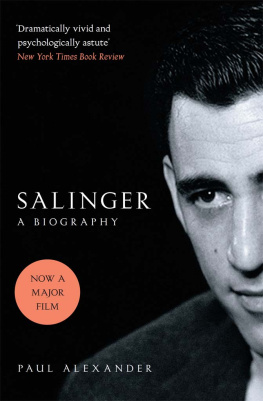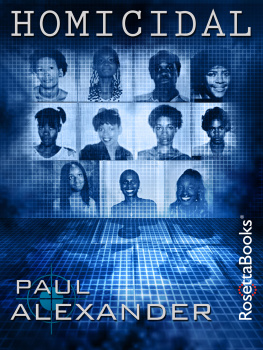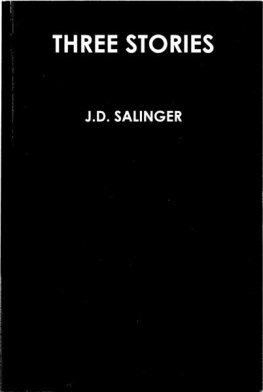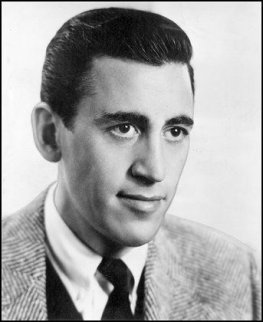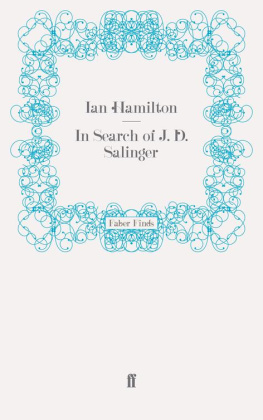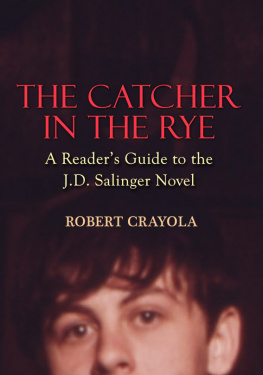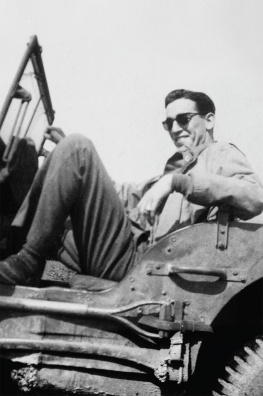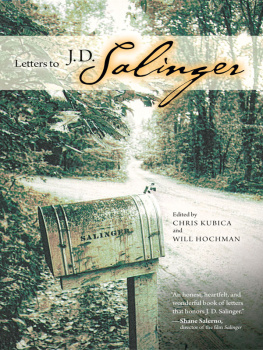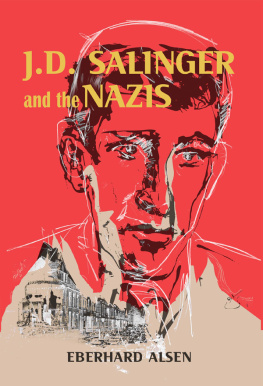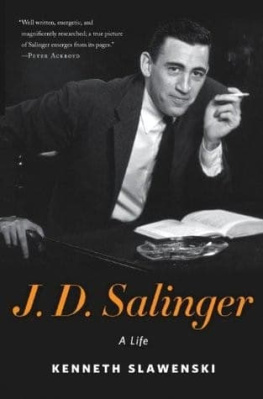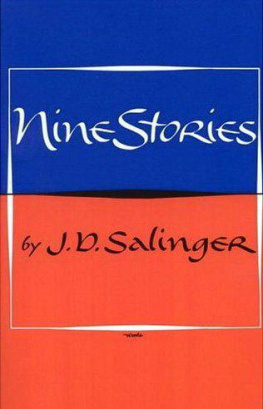
for Christopher Gines
for Lauren Alexander
for my family
and for James C. Vines III,
literary raconteur extraordinaire,
without whom this book would not exist
Dont you want to join us?
I was recently asked by an acquaintance when he ran across me alone after midnight in a coffeehouse that was already almost deserted.
No, I dont, I said.
FRANZ KAFKA
as quoted by Salinger in Zooey
Acknowledgments
After he was prevented from publishing A Writers Life, his biography of J. D. Salinger, Ian Hamilton deposited his entire Salinger research file in the Department of Rare Books and Special Collections at Princeton University Library. Anyone can read the sizable file, which I did. As I studied the documents, I found much biographical material Hamilton had not used in writing In Search of J. D. Salinger, the book about the controversy that he produced when the courts blocked the publication of A Writers Life. I was also helped immensely by the New Yorker archive at the New York Public Library, which became open to the public after Hamilton published In Search of J. D. Salinger. Mine is the first book to use this important archive as source material. In addition, I did research work in or was supplied with research material by various libraries at Columbia University, New York University, and the University of Texas as well as the rare book and manuscript collection at Virginia Polytechnic Institute and State University, the Gotham Book Mart, the Library of Congress Copyright Office, and the alumni offices at Harvard University and Yale University. In the Clerks Office in the county courthouse in Sullivan County, New Hampshire, I found Salingers divorce papers, which had not been studied by other biographers before. Finally, through various sources, I was able to piece together much of what was said in Salingers deposition in J. D. Salinger versus Random House and Ian Hamiltonthe only formal interview for which Salinger has ever sat.
As for secondary sources, I read Advertisements for Myself by Norman Mailer, At Home in the World and Baby Love by Joyce Maynard, Chaplin by David Robinson, Charles Chaplin: My Autobiography by Charles Chaplin, Conversations with Capote by Lawrence Grobel, Dirty Little Secrets of World War II by James F. Dunnigan and Albert A. Nofi, The Fiction of J. D. Salinger by Frederick Gwynn and Joseph Blotner, The Films of Susan Hayward by Eduardo Moreno, Genius in Disguise by Thomas Kunkel, Goldwyn by A. Scott Berg, Here at the New Yorker by Brendan Gill, Here But Not Here by Lillian Ross, In Search of J. D. Salinger by Ian Hamilton, J. D. Salinger by Warren French, J. D. Salinger by James Lundquist, J. D. Salinger: An Annotated Bibliography by Jack R. Sublette, J. D. Salinger and the Critics edited by William Belcher and James Lee, The Journals of Sylvia Plath by Sylvia Plath, Lolita by Vladimir Nabokov, Louise Bogan by Elizabeth Frank, Modern European History by John Barber, Salinger: A Critical and Personal Portrait edited by Henry Grunwald, Salingers Glass Stories as a Composite Novel by Eberhand Alsen, Translate This Darkness by Claire Douglas, Trio: The Intimate Friendship of Carol Matthau, Oona Chaplin, and Gloria Vanderbilt by Aram Saroyan, United States by Gore Vidal, What I Know So Far by Gordon Lish, A Writers Life (galleys only) by Ian Hamilton.
Several magazine articles were of great value, among them In Search of the Mysterious J. D Salinger by Ernest Havemann (Life, November 3, 1961); J. D. Salinger by William Maxwell (Book-of-the-Month Club News, July 1951); The Private World of J. D. Salinger by Edward Kosner (The New York Post Magazine, April 30,1961); Sonny: An Introduction (Time, September 15, 1961); Tiny Mummies! and Lost in the Whichy Thicket by Tom Wolfe (New York, April 1965); What I Did Last Summer by Betty Eppes (The Paris Review, 1981). For their interviews, research material, or other help, Id like to thank William Abbe, N. Wade Ackley, Paul Adao, Roberta Adao, Mark Alspach, A. Alvarez, Roger Angell, William Avery, Alex Beam, John Calvin Batchelor, A. Scott Berg, Naomi Bliven, Harold Bloom, Andreas Brown, Troy Cain, Robert Callagy, Ann Close, Kathy Constantini, Richard D. Deitzler, Elizabeth Drew, James Edgerton, Leslie Epstein, Clay Felker, Ian Frazier, Dorothy B. Ferrell, Warren French, Frances Glassmoyer, Robert Giroux, Jonathan Goldberg, Richard Gonder, Lawrence Grobel, Leila Hadley, Ian Hamilton, Lianne Hart, Edward W. Hayes, Susie Gilder Hayes, Samuel Heath, Anabel G. Heyen, Franklin Hill, Rust Hills, Phoebe Hoban, Russell Hoban, William H. Honan, A. E. Hotchner, Peter Howard, Robert Jaeguers, Burnace Fitch Johnson, Richard Johnson, Elaine Joyce, Frances Kiernan, Mary D. Kierstead, Edward Kosner, Thomas Kunkel, Penny Landau, Robert Lathbury, Gordon Lish, Rebecca Lish, Mary Loving, Gigi Mahon, Ved Mehta, Daniel Meneker, Sylvia Miles, Gloria Murray, Norman Nelson, Ethel Nelson, Katrinka Pellechia, George Plimpton, Paige Powell, Ron Rosenbaum, Jennifer Lish Schwartz, Jonathan Schwartz, Al Silverman, Dinitia Smith, Michael Solomon, Charles Steinmetz, Roger Straus, Gay Talese, Joan Ullman, Amanda Vaill, Gus Van Sant, Daniel White, Maura Wogan, Tom Wolfe, and Ben Yagoda. For his friendship and advice Id also like to acknowledge James Ortenzio, someone whos always there when hes needed.
While I worked on this book, I wrote Talk of the Town, an article about Lillian Ross and William Shawn, and J. D. Salingers Women for New York, where Im lucky to have John Homans as my editor. It takes years to write a book, so as Im working on one I often write for magazines. Id like to thank my editors at the various publications I work for who have supported me while Ive written this bookLaurie Abraham, Tom Beer, Richard Blow, Robin Cembalest, Lisa Chase, Will Dana, Jessica Dineen, Milton Esterow, Erika Fortgang, Mark Horowitz, Lisa Kennedy, Robert Love, Caroline Miller, Roberta Meyers, Nancy Novograd, and Maer Roshan. At Renaissance Books, Id like to thank Bill Hartley and Richard OConnor as well as Arthur Morey whose notes, insights, and suggestions were invaluable. Finally, I want to express my gratitude to Betsy Cummings for assisting me in researching Salingers life and work.
Preface
When J. D. Salinger created Holden Caulfield during the 1940s (he worked on some form of The Catcher in the Rye for ten years before it was published in 1951), he had few models to look to. As critics have pointed out, the one character comparable to Holden in earlier American literature is Huckleberry Finn in Mark Twains classic The Adventures of Huckleberry Finn. Holden is on a quest through New England, and then New York City, much as Huck is on a quest on the Mississippi River. Holden encounters the ugliness of the adult world much as Huck confronts the shocking reality of racism and bigotry. Huckleberry Finn is the seminal coming-of-age novel in nineteenth-century American literature; The Catcher in the Rye occupies a similar place in the literature published after 1950.
Salinger has become such a notable literary figure that he actually appears as a character in W. P. Kinsellas Shoeless Joe, the novel on which the picture Field of Dreams
Next page
